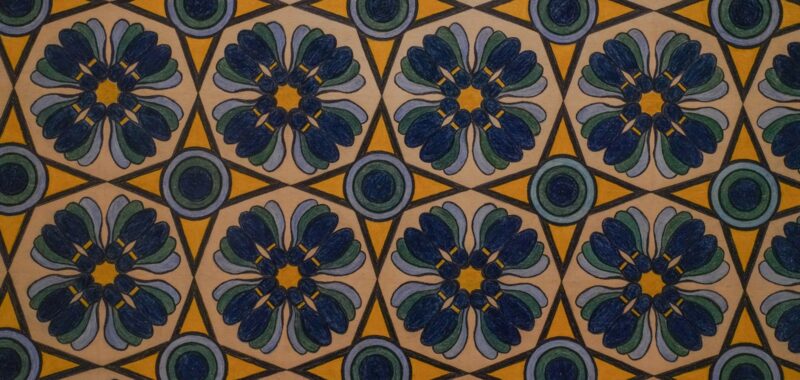Past the marble bank facade that anchors the Metropolitan Museum of Art’s American Wing awaits Mary Sully: Native Modern, the first solo show of the self-taught Yankton Dakota artist who worked mostly in obscurity from the 1920s through ’40s. Stepping into the first orderly gallery feels like stumbling upon a secret room in your home, akin to a scene from a dream or a storybook. With its trove of 25 drawings bearing the singular creative vision of Mary Sully (born Susan Mabel Deloria), the exhibition serves as a passageway between the overlapping spheres of Modernism and Native art.
Born on the Standing Rock Reservation in South Dakota in 1896, Sully made art throughout her reclusive and itinerant life. Her signature, three-paneled colored pencil drawings, which combine references to US pop culture and Native culture, comprise the bulk of her roughly 200-piece body of work. During her lifetime, Sully never exhibited her work in formal art spaces, nor did she make money from her art.
After spending years in the dark of a cardboard box and then a suitcase, which bounced between family members and even survived a house fire, Sully’s artwork recently surfaced into public view after it captured the imagination of her great-nephew, historian Philip J. Deloria (Yankton Dakota). In 2019, his book Mary Sully: Toward an American Indian Abstract introduced the artist’s life and work to the world at large. Since then, The Met has acquired some of Sully’s drawings, several of which take the spotlight in this exhibition.
In the first gallery, two selections of art line parallel walls. The drawings examine societal topics on one side, like greed and divorce, and Native imagery on the other, such as symbols, amulets, and objects including fringed bags and leather boxes. A short video feature by Paramount Pictures from 1933 shows the artist at work, and a case displays family objects — a beaded bible and stole, photos, books. The second and larger gallery is devoted to a series of works that Sully dubbed “personality prints.” These aren’t prints in the printmaking sense of the term, but, rather hand-drawn portraits that symbolize a celebrity or notable figure, the sort of person she likely saw featured in Time magazine, as Deloria notes in his book.



Each drawing is rendered on paper with the same set of materials — colored pencil, black ink, white paint, and pastel crayon — and typically follows a three-panel format to interpret and refract the subject through abstract yet representational imagery. Sully devotes the top panel of each piece to capturing the essence of her subject through narrative symbols and shapes. In “Fred Astaire (1899–1987)” (c. 1920s–40s), footprints denote movement and nimble choreography. The middle panel riffs on the imagery established in the first panel, zooming in on particular forms to create a graphic pattern, inflected with Art Nouveau style. These repeating designs also echo mainstream American textiles of the era, such as the popular novelty prints produced by Stehli Silks Corporation. The third panel brings in Native imagery, often referencing Plains Indian culture, stories, objects, and motifs used in beadwork and leatherwork. And every panel, regardless of its placement, is a symmetrical mirror image.
Across these drawings, patterns pulse and geometric shapes tessellate. Abstraction gives way to representation, and vice versa. Flowers, faces, and fashions, like Easter parade outfits and Native regalia, blend with graphic pops and geometric patterns, like six-pointed stars and color blocks. Symbols populate the portraits, including abstracted music notes for baritone Lawrence Tibbett, roses for writer Gertrude Stein (a nod to her line of verse “a rose is a rose is a rose is a rose”), and diamonds for baseball legend Babe Ruth. A short biography in the form of wall text accompanies each “personality print,” providing a glimpse into the celebrity culture of the era and what may have inspired the artist to put pencil to paper.
Evincing a keen color and design sense, Sully’s layered drawings blend varied cultural references and bring Modernist and Native art together in fresh ways. Her art deftly reveals, blends, and complicates ideas that surround both of these designations, expanding the picture of what 20th-century art looks like. And this survey exhibition locates Sully’s distinctive artistic voice in this rich intersection of art history — no longer lost in the shuffle.





Mary Sully: Native Modern continues at the Metropolitan Museum of Art (1000 Fifth Avenue, Upper East Side, Manhattan) through January 12, 2025. The exhibition was curated by Patricia Marroquin Norby and Sylvia Yount.

